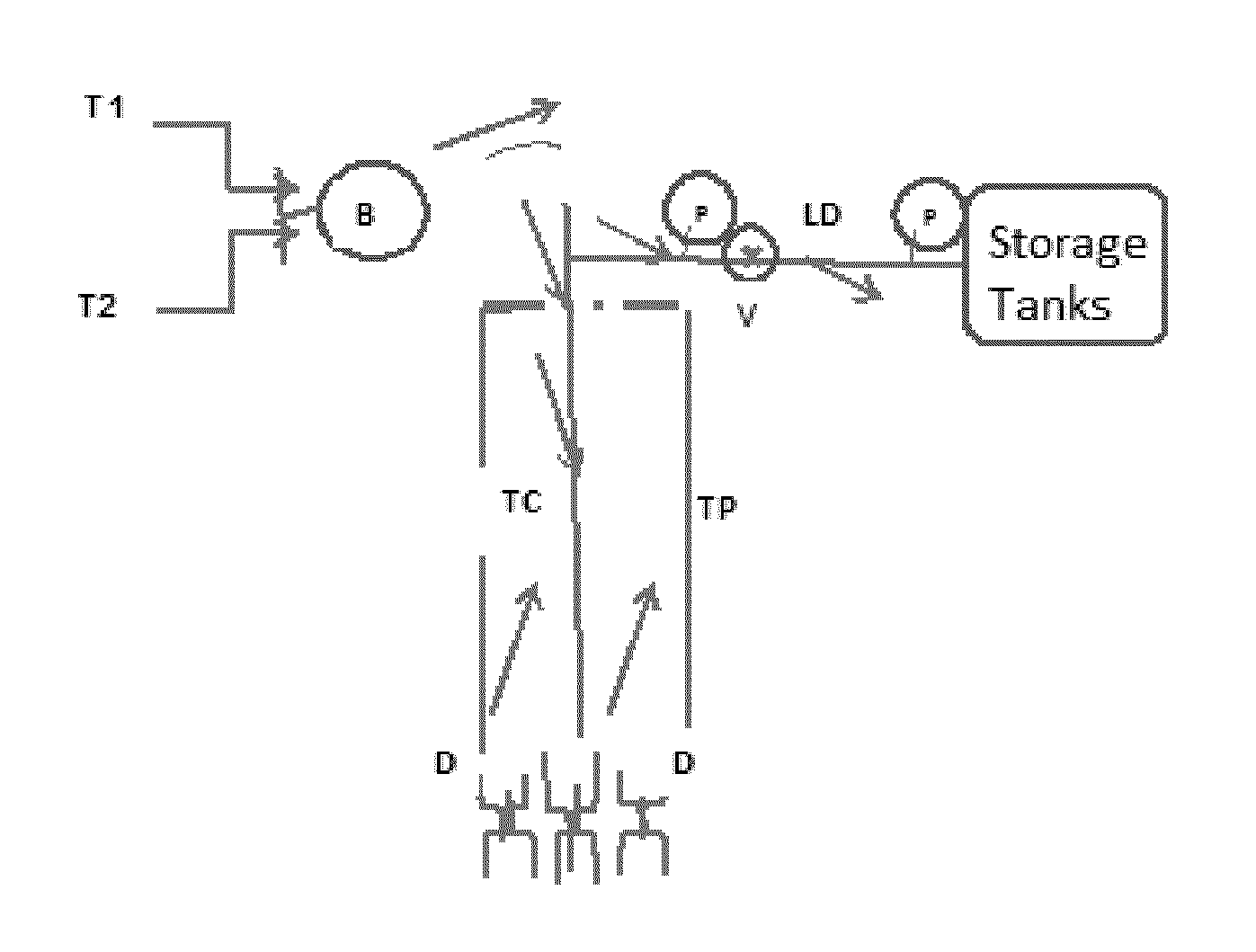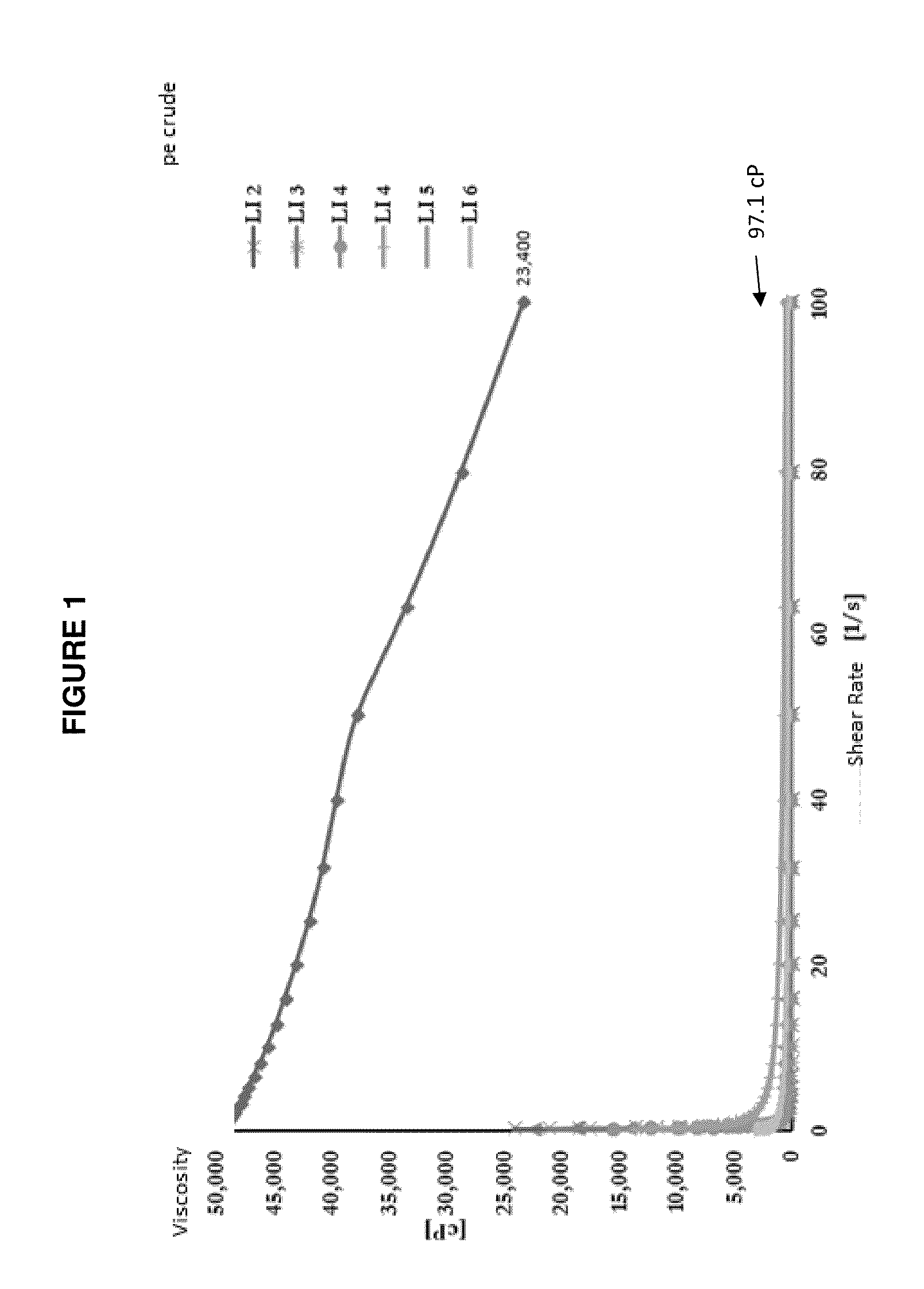Application of a chemical composition for viscosity modification of heavy and extra-heavy crude oils
a technology of petroleum crude oil and chemical composition, which is applied in the direction of thickeners, sealing/packing, borehole/well accessories, etc., can solve the problems of reducing affecting the economic value and presenting technical difficulties in handling and transportation of extra-heavy crude oil. , to achieve the effect of promoting the mobility of heavy, reducing the viscosity of heavy crude oil, and increasing the productivity of well
- Summary
- Abstract
- Description
- Claims
- Application Information
AI Technical Summary
Benefits of technology
Problems solved by technology
Method used
Image
Examples
example 1
[0068]A chemical composition is prepared using common procedures as reported elsewhere, which consist mainly of condensation reactions, for obtaining a composition with a general formula CnH2n-1ClN2]x [H2O]y where 8≦n≦12; the coefficients x, and y are calculated according to the volume of the crude oil (z) in the following range: (1) x+y=0.05 z and (2) x+y=0.66 z, with respect to the volume of crude oil, and where z=1, the ratio x / y vary preferably in the range between 2×10−4 and 1×10−3. Also, some variations of this composition are obtained by modification of the abovementioned formulation, for example by inserting an oxirane type polymer chain, as reported hereinafter, to obtain additional products with the general formula CnH2n-1ClN2(C3H6O)2x, where the value of n depends on the type of crude oil to treat. For example, in the case of a crude oil having the characteristics of C1 type crude oil (Tables 1 to 3) preferably n=11. If the water cut of the crude oil is high enough, e.g.,...
example 2
[0079]A chemical composition was prepared in accordance with the present invention, which has the general formula CnH2n-mClN2O2, with 2≦n≦10, 1≦m≦6 through a condensation reaction, which is modified to obtain a composition with general formula CnH2n-mClN2O2 (C3H6O)2x, where preferably the value of n depends on the type of crude oil to be treated. For example, in the case of a C1 type crude oil (Tables 1-3) n=7 and m=1. This chemical composition is not used directly but it is dispersed in aqueous or organic means, then it is combined with a surfactant, which can be either natural or synthetic. Examples of suitable surfactants include alkyl-sulfonate of alkylamine, alkyl-sulfonate-of-poly-alkyl-amine, polyoxyethylene-alcohol, polyoxyethylene-alkyl-amine, polyoxyethylene-alkyl-amide and carboxy-methyl-cellulose sodium alkanol amides, alkanol amines, glycol-esters, polyglycerol esters, polyoxy-alkylene-polyol-ester, and ethylene-glycol monoester.
[0080]Once integrated as described herein...
example 3
[0084]A chemical composition of the present invention is prepared according to the procedures established in the art of organic synthesis, with scaling factors for carrying out large-scale semi-industrial and industrial-scale synthesis, which can be based on the qualities and quantities described herein. According to this invention the proportions are based upon laboratory studies and reference data. For example, the chemical composition that is the subject of this invention is characterized by IR spectroscopic data as follows: IR (near) 3500, 2850, 2785, 2250, 1690, 1480, 1078 cm−1; 1H NMR (300 MHz, CDCl3) δ 0.96 (m, 3H), 1.33 (m, 6H), 3.63 (s, 3H), 7.4 (d, 1H), 7.6 (d, 1H), 10.1 (s, 1H); 13C NMR (300 MHz) δ 13.8, 20.8, 32.2, 37.9, 58.2, 118, 122.8, 123.0, 137.0; the calculation HRMS for CnHmNpO2 is 205.25, while the finding is 205.84, where 8≦n≦10, m=n+4 y 2≦p≦8 and 9≦n≦12, m=n+4 and 4≦p≦6. This chemical composition is then modified by a polymerization reaction to obtain the chemi...
PUM
| Property | Measurement | Unit |
|---|---|---|
| Reynolds number | aaaaa | aaaaa |
| pressures | aaaaa | aaaaa |
| pressures | aaaaa | aaaaa |
Abstract
Description
Claims
Application Information
 Login to View More
Login to View More - R&D
- Intellectual Property
- Life Sciences
- Materials
- Tech Scout
- Unparalleled Data Quality
- Higher Quality Content
- 60% Fewer Hallucinations
Browse by: Latest US Patents, China's latest patents, Technical Efficacy Thesaurus, Application Domain, Technology Topic, Popular Technical Reports.
© 2025 PatSnap. All rights reserved.Legal|Privacy policy|Modern Slavery Act Transparency Statement|Sitemap|About US| Contact US: help@patsnap.com



